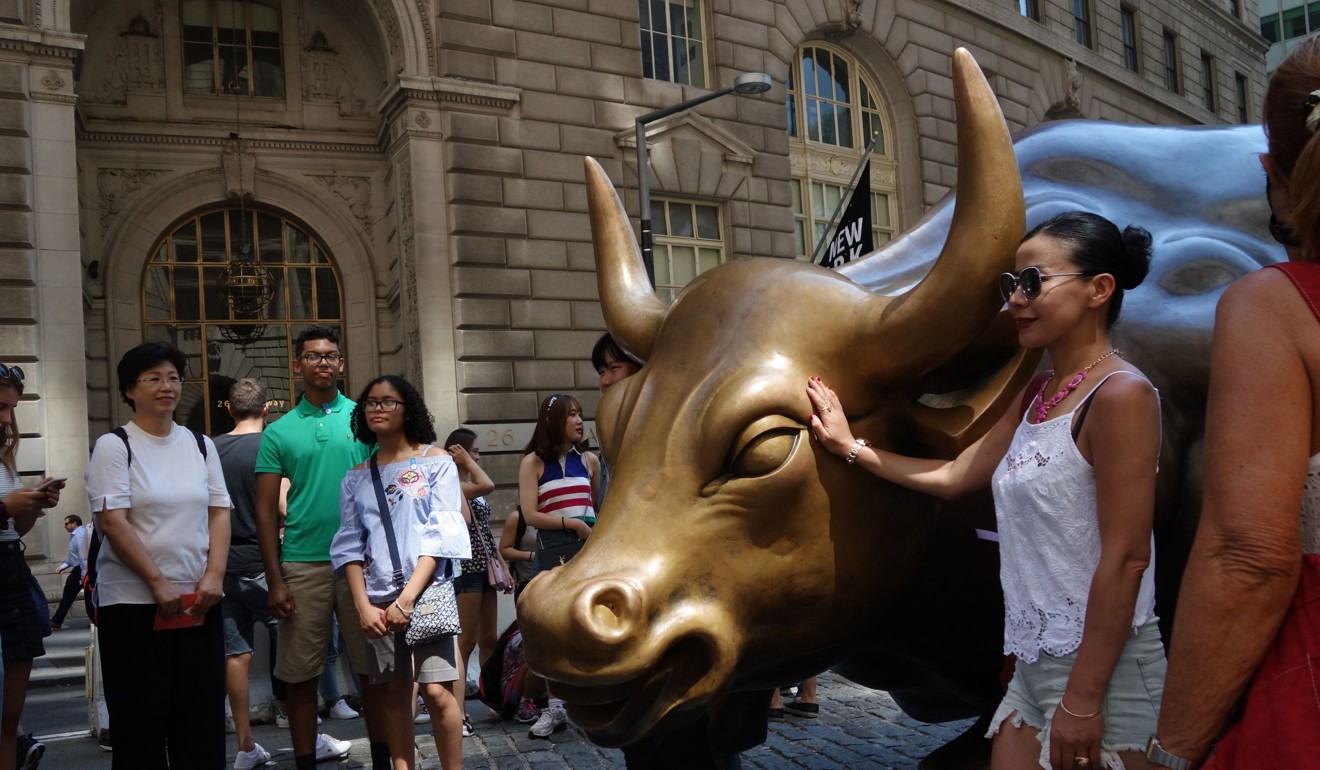
Dow Jones ends above 22,000 for first time as rally in Apple shares lift index
The Dow climbed above the 22,000 mark for the first time on Wednesday, buoyed by Apple’s healthy quarterly iPhone sales, while weakness in other tech stocks held back the Nasdaq and S&P 500.
Apple jumped 4.73 per cent to a record high after the world’s largest publicly listed company reported strong results. It is up 36 per cent this year.
Apple shares traded at US$157.14 after hitting a record high of US$159.75 in the wake of its earnings, helping lift the Dow above the 22,000 mark.
The iPhone maker’s rise helped push the Dow to a record closing high, although tech heavyweights Microsoft, Facebook and Alphabet all lost ground following recent strong gains that have made the sector the strongest performer in 2017.
Some investors believe corporations must start spending less on buying back shares and more on technology to improve productivity in order to justify further gains in Silicon Valley stocks, with the S&P 500 information technology index already up 23 per cent this year.
“Apple, at the heart of it, has a lot of consumer exposure, and the consumer is in great shape. But we would like to see some capex,” said Mike Baele, managing director at US Bank Private Client Wealth Management in Portland, Oregon. Microsoft slipped 0.44 per cent and Facebook lost 0.33 per cent, both among the heaviest drags on the S&P 500 and the Nasdaq.
The Dow Jones Industrial Average rose 52.32 points, or 0.24 per cent, to 22,016.24, the S&P 500 gained 1.22 points, or 0.05 per cent, to 2,477.57 and the Nasdaq Composite dropped 0.29 points to 6,362.65.
The pan-European FTSEurofirst 300 index lost 0.41 per cent and MSCI’s gauge of stocks across the globe shed 0.02 per cent.
The Dow has risen 11 per cent in 2017 and is on track for its sixth straight record close, even as Wall Street loses confidence that President Donald Trump and a Republican-controlled Congress will be able to cut taxes and increase infrastructure spending this year.
Apple reported better-than-expected iPhone sales, revenue and earnings-per-share, and signalled its upcoming 10th-anniversary phone is on schedule.
Apple’s gains were just enough to help keep the broader US stock indexes out of negative territory, as the benchmark S&P 500 eked out a slight gain and the Nasdaq ended flat.
“Obviously it’s a big fat number, typically at those big round numbers the market seems to hesitate,” said Mark Luschini, chief investment strategist at Janney Montgomery Scott in Philadelphia.
“I’m looking at this as a situation where the underlying evidence as to why the stock market has responded as well as it has so far this year is the fertile climate for corporate profits, which is likely to remain so.”
European shares were weighed down by declines in banking and mining shares.
The US dollar hit its lowest level against the euro in more than 2-1/2 years on uncertainty over the path of interest rate hikes for the Federal Reserve this year and expectations for European Central Bank hawkishness.
Tepid US inflation and political turmoil in Washington have lessened the possibility of another Federal Reserve rate hike this year.
Improving data in other major economies has also served to push the greenback down nearly 11 per cent from January highs, benefiting commodities and emerging markets.
The dollar index fell 0.17 per cent, after touching 92.548, the lowest since early May 2016. The euro was up 0.45 per cent to US$1.1854.

Investors also dealt with conflicting statements from Federal Reserve officials.
St Louis Federal Reserve James Bullard is opposed to further US interest rate increases by the central bank, Market News International reported, and warned that more hikes could hinder domestic inflation.
Cleveland Fed President Loretta Mester, however, said the Fed should remain focused on gradually tightening US policy because one-off factors, not a long-lasting trend, have caused inflation to weaken in recent months.
US private employers added 178,000 jobs in July, below economists’ expectations, a report by a payrolls processor showed on Wednesday, ahead of the US Labour Department’s more comprehensive non-farm payrolls report on Friday.

US profits for the second quarter have been strong, with earnings growth currently at 11.4 per cent, according to Thomson Reuters data. Of the 350 companies in the S&P 500 that have reported through Wednesday morning, 70 per cent have topped expectations.
Benchmark 10-year notes last fell 4/32 in price to yield 2.2656 per cent, from 2.251 per cent late on Tuesday.
US crude settled up 0.9 per cent at US$49.59 per barrel and Brent settled up 1.1 per cent at US$52.36 on the day as surging US fuel demand offset data from the Energy Department that showed crude inventories did not fall as much as expected last week.

